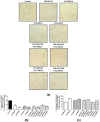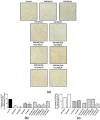In Silico and In Vitro Analysis of Sulforaphane Anti- Candida Activity
- PMID: 36551499
- PMCID: PMC9774275
- DOI: 10.3390/antibiotics11121842
In Silico and In Vitro Analysis of Sulforaphane Anti- Candida Activity
Abstract
Oropharyngeal candidiasis/candidosis is a common and recurrent opportunistic fungal infection. Fluconazole (FLZ), one of the most used and effective antifungal agents, has been associated with a rise of resistant Candida species in immunocompromised patients undergoing prophylactic therapy. Sulforaphane (SFN), a compound from cruciferous vegetables, is an antimicrobial with yet controversial activities and mechanisms on fungi. Herein, the in silico and antifungal activities of SFN against C. albicans were investigated. In silico analyzes for the prediction of the biological activities and oral bioavailability of SFN, its possible toxicity and pharmacokinetic parameters, as well as the estimates of its gastrointestinal absorption, permeability to the blood-brain barrier and skin, and similarities to drugs, were performed by using different software. SFN in vitro anti-Candida activities alone and in combination with fluconazole (FLZ) were determined by the broth microdilution method and the checkerboard, biofilm and hyphae formation tests. Amongst the identified probable biological activities of SFN, nine indicated an antimicrobial potential. SFN was predicted to be highly absorbable by the gastrointestinal tract, to present good oral availability, and not to be irritant and/or hepatotoxic. SFN presented antifungal activity against C. albicans and prevented both biofilm and hyphae formation by this microorganism. SFN was additive/synergistic to FLZ. Overall, the data highlights the anti-Candida activity of SFN and its potential to be used as an adjuvant therapy to FLZ in clinical settings.
Keywords: Candida albicans; antifungal activity; in silico analysis; sulforaphane.
Conflict of interest statement
The authors declare no conflict of interest.
Figures




Similar articles
-
Ellagic Acid Potentiates the Inhibitory Effects of Fluconazole Against Candida albicans.Antibiotics (Basel). 2024 Dec 4;13(12):1174. doi: 10.3390/antibiotics13121174. Antibiotics (Basel). 2024. PMID: 39766564 Free PMC article.
-
Potential effect of 2-isopropyl-5-methylphenol (thymol) alone and in combination with fluconazole against clinical isolates of Candida albicans, C. glabrata and C. krusei.J Mycol Med. 2018 Jun;28(2):294-299. doi: 10.1016/j.mycmed.2018.04.002. Epub 2018 Apr 14. J Mycol Med. 2018. PMID: 29661606
-
Thymus vulgaris essential oil and thymol inhibit biofilms and interact synergistically with antifungal drugs against drug resistant strains of Candida albicans and Candida tropicalis.J Mycol Med. 2020 Apr;30(1):100911. doi: 10.1016/j.mycmed.2019.100911. Epub 2019 Nov 7. J Mycol Med. 2020. PMID: 32008964
-
Efficacy of Flavonoids in Combating Fluconazole Resistant Oral Candidiasis.Curr Pharm Des. 2022;28(21):1703-1713. doi: 10.2174/1381612828666220324140257. Curr Pharm Des. 2022. PMID: 35331090 Review.
-
Molecular epidemiology, antifungal susceptibility, and ERG11 gene mutation of Candida species isolated from vulvovaginal candidiasis: Comparison between recurrent and non-recurrent infections.Microb Pathog. 2022 Sep;170:105696. doi: 10.1016/j.micpath.2022.105696. Epub 2022 Jul 31. Microb Pathog. 2022. PMID: 35921954 Review.
Cited by
-
Investigating Sulforaphane's anti-virulence and anti-quorum sensing properties against Pseudomonas aeruginosa.Front Pharmacol. 2024 May 21;15:1406653. doi: 10.3389/fphar.2024.1406653. eCollection 2024. Front Pharmacol. 2024. PMID: 38835668 Free PMC article.
-
Ellagic Acid Potentiates the Inhibitory Effects of Fluconazole Against Candida albicans.Antibiotics (Basel). 2024 Dec 4;13(12):1174. doi: 10.3390/antibiotics13121174. Antibiotics (Basel). 2024. PMID: 39766564 Free PMC article.
-
Antimicrobial and Anti-Infective Activity of Natural Products-Gaining Knowledge from Novel Studies.Antibiotics (Basel). 2023 Jun 15;12(6):1051. doi: 10.3390/antibiotics12061051. Antibiotics (Basel). 2023. PMID: 37370369 Free PMC article.
-
Biochanin A Inhibits the Growth and Biofilm of Candida Species.Pharmaceuticals (Basel). 2024 Jan 9;17(1):89. doi: 10.3390/ph17010089. Pharmaceuticals (Basel). 2024. PMID: 38256922 Free PMC article.
References
-
- Khedri S., Santos A.L.S., Roudbary M., Hadighi R., Falahati M., Farahyar S., Khoshmirsafa M., Kalantari S. Iranian HIV/AIDS patients with oropharyngeal candidiasis: Identification, prevalence and antifungal susceptibility of Candida species. Lett. Appl. Microbiol. 2018;67:392–399. doi: 10.1111/lam.13052. - DOI - PubMed
Grants and funding
- grant numbers: 305676/2019-9 and 408053/2018-6 to E.S.F and 315072/2020-2 to V.M.-N./National Council for Scientific and Technological Development
- NA/Instituto de Pesquisa Pelé Pequeno Príncipe
- NA/INCT-INOVAMED
- ACT-05691/21/Fundação de Amparo à Pesquisa e ao Desenvolvimento Científico e Tecnológico do Maranhão
- finance code 001/Coordenação de Aperfeicoamento de Pessoal de Nível Superior
LinkOut - more resources
Full Text Sources
Research Materials
Miscellaneous

